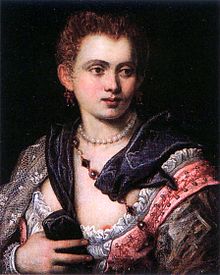
Portrait of Veronica Franco by Tintoretto, 1575.
Veronica Franco (1546-1591) was a poet and courtesan in sixteenth century Venice. There were two types of courtesans during this period: the upper class, intellectual cortigiana onesta, and cortigiana di lume, the lower class courtesans. Veronica was one the most successful and popular cortigiana onesta courtesans of her time.
Her mother, Paola Fracassa, was also a cortigiana onesta who brought Veronica up to be well educated, and to use her natural assets to ensure she got a good marriage. In her teens she married the wealthy physician, Paolo Panizza, but the couple separated shortly after. To support herself, she followed her mothers footsteps and became a high class courtesan. She was very successful, partly due to her extensive education which began with her brothers, whom she shared a tutor with. She could play both the lute and the spinet, and she read both ancient Greek and Roman literature. She mixed in cultured circles of artists, politicians, poets and great thinkers. She made use of her education to write two volumes of poetry: Terze Rime in 1575 and Lettere familiari a diversi in 1580.
She had 6 children by different men, but only 3 of them survived past infancy. She supported a large household filled with children, tutors and servants. For a decade or so she lived in decadence thanks to her great success as a courtesan, as she is even believed to have had a liaison with Henry III of France.
Sadly, her life grew hard in later years. In 1575 she fled Venice because the plague had come to Italy, but while she was away her home was looted and many of her valuable possessions were stolen. Two years later her son’s tutor, Ridolfi Vannitelli, accused her of practicing witchcraft in her home. This was not an uncommon accusation against courtesans, but was very dangerous. Veronica managed to have the charges dropped, thanks to her friend and patron Domenico Venier, her defence, and the sympathies of the inquisitor. However it destroyed her reputation, and the death of her most loyal patron Venier a few years later led her into poverty. She ended her life in the area of Venice many poor courtesans ended up, and died at the age of 45.
-Danielle Triggs
Junior Girl
Girl Museum Inc.
